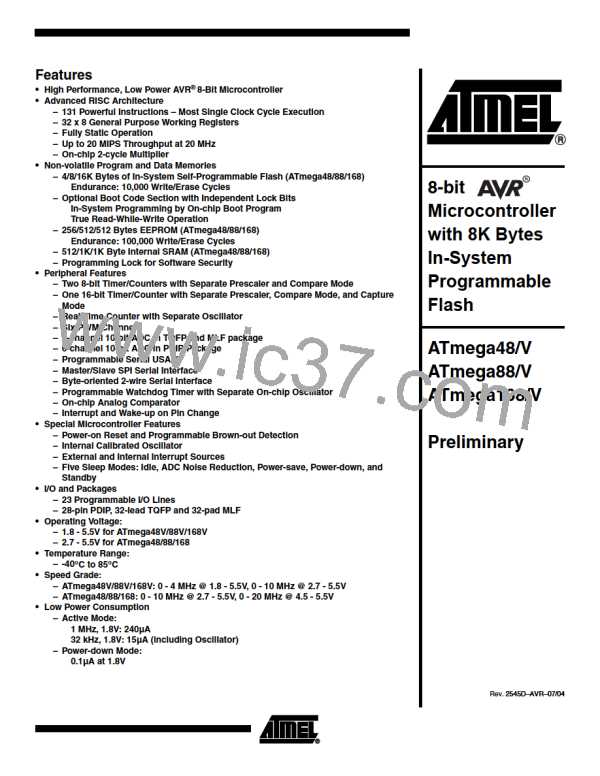Memory
Programming
Program And Data
Memory Lock Bits
The ATmega88/168 provides six Lock bits which can be left unprogrammed (“1”) or can
be programmed (“0”) to obtain the additional features listed in Table 116. The Lock bits
can only be erased to “1” with the Chip Erase command.The ATmega48 has no sepa-
rate Boot Loader section. The SPM instruction is enabled for the whole Flash if the
SELFPRGEN fuse is programmed (“0”), otherwise it is disabled.
Table 115. Lock Bit Byte(1)
Lock Bit Byte
Bit No
Description
–
Default Value
7
6
5
4
3
2
1
0
1 (unprogrammed)
1 (unprogrammed)
1 (unprogrammed)
1 (unprogrammed)
1 (unprogrammed)
1 (unprogrammed)
1 (unprogrammed)
1 (unprogrammed)
–
BLB12(2)
Boot Lock bit
Boot Lock bit
Boot Lock bit
Boot Lock bit
Lock bit
BLB11(2)
BLB02(2)
BLB01(2)
LB2
LB1
Lock bit
Notes: 1. “1” means unprogrammed, “0” means programmed
2. Only on ATmega88/168.
Table 116. Lock Bit Protection Modes(1)(2)
Memory Lock Bits
Protection Type
LB Mode
LB2
LB1
1
1
1
No memory lock features enabled.
Further programming of the Flash and EEPROM is
disabled in Parallel and Serial Programming mode. The
Fuse bits are locked in both Serial and Parallel
Programming mode.(1)
2
1
0
0
0
Further programming and verification of the Flash and
EEPROM is disabled in Parallel and Serial Programming
mode. The Boot Lock bits and Fuse bits are locked in both
Serial and Parallel Programming mode.(1)
3
Notes: 1. Program the Fuse bits and Boot Lock bits before programming the LB1 and LB2.
2. “1” means unprogrammed, “0” means programmed
270
ATmega48/88/168
2545D–AVR–07/04

 ATMEL [ ATMEL ]
ATMEL [ ATMEL ]